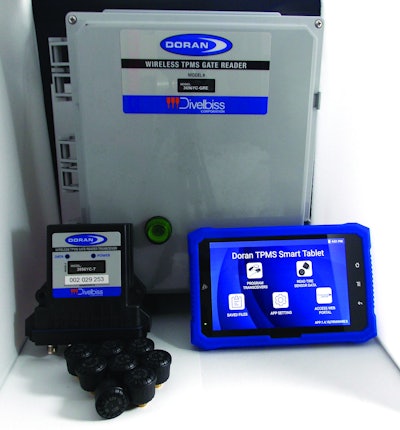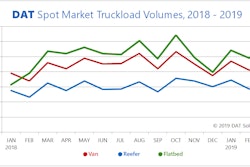 The new YardCheck 360 system from Doran monitors tire pressures on dropped trailers.
The new YardCheck 360 system from Doran monitors tire pressures on dropped trailers.The air pressure of trailer tires is a persistent challenge to manage. When assets are dropped at fleet terminals and customer locations they may not be seen or touched for days or weeks at a time.
Slow air leaks escape detection and the resulting low pressure degrades fuel economy and triggers unplanned maintenance events.
Automatic tire inflation systems can alleviate some of these concerns, but they are useful only when trailers are connected with tractors that supply the air pressure. Fleets are often unaware of tire problems until trailers are loaded and the driver sees a warning indicator light from the inflation system.
Checking in at the gate
One way to manage dropped trailers is with tire pressure monitoring systems (TPMS) that alert drivers through LED indicator lights. A more high-tech option allows for data to be transmitted from wheel-mounted sensors to the office using short-range and wide-area wireless networks.
The AirBAT RF tire pressure monitoring system from Stemco uses radio frequency (RF) technology to transmit tire data through a gateway reader from wheel sensors that capture sensor data, fuel usage information and mileage readings.
AirBAT RF can integrate with trailer and tractor telematics providers to gather and display information, the company says.
Doran Manufacturing recently added a new TPMS product to its lineup called YardCheck 360. The system uses valve sensors that connect wirelessly to a transceiver device mounted to the trailer.
The valve sensors are compatible with automatic tire inflation systems. They are able to be connected to the existing hoses with an inline “T” fitting, says Jim Samocki, the company’s vice president and general manager.
The transceiver has rechargeable batteries that draw power from the tractor through the trailer’s 7-way pin connector. The device communicates tire pressures and temperatures to the office when trailers are within range of a dedicated Gateway Reader with a Wi-Fi router stationed at their facilities.
Doran’s reader uses a Wi-Fi signal with amplified coverage of up to three miles in diameter. When a trailer is outside a Wi-Fi connection, such as at a shipper facility, the transceiver captures tire data for later transmission.
Connectivity options
When a trailer is disconnected from a tractor, the transceiver of the YardCheck 360 system wakes up every 24 hours to send tire pressure and temperature updates through the Gateway Reader. Email alerts are sent to fleet managers if any tires need attention, he says.
Tire pressure and temperature data is monitored using a dashboard in a web portal. The data can also be download into existing tire maintenance software packages by using a CSV file, he says.
Doran is working with trailer tracking providers on integrations that would make it possible to use existing wide-area cellular or satellite networks to connect to the office, he says.
The transceiver for YardCheck 360 is designed to last more than a decade and its sensors have a useful life of more than five years, he says.
YardCheck 360 is compatible with Doran’s existing product, SmartLink, that captures tire pressure data from sensors installed on all 18 or more tires. The trailer-mounted transceiver communicates with a similar device on the tractor, which sends sensor data from tires through the vehicle’s J1939 databus to be picked up and displayed by devices in the cab.
Drivers can view tire pressure data and alerts on all 18 wheels by using a SmartLink device or the in-cab display unit from telematics providers that include Omnitracs, PeopleNet and Geotab. Fleet managers in the office view information through a web portal when the tire data is transmitted to the office through cellular or satellite networks.
To solve the dilemma of trailer tires, the latest TPMS systems are using smart sensors, wireless networks and cloud-based services to give drivers and fleet managers information that may otherwise not be detected for an extended period of time.











